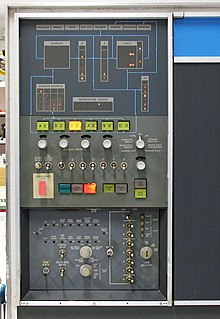IBM 1401
The IBM 1401 was a transistor-based , core memory- equipped computer from IBM . It was the nucleus of "Electronic Data Processing" EDP . In contrast to (most) today's computers, the extent of a field consisting of several (connected) memory locations was not determined by information in the machine command, but by so-called word marks in the memory. The computer worked with a variable word length, which means that the storage capacity can be used very efficiently.
This calculator was introduced on October 5, 1959. He was able to replace tabulating machines like the IBM 407 . It had been sold over 12,000 times by the end of production on February 8, 1971. It was also possible to rent the computer from IBM, although in the early 1960s a monthly rent of USD 2500 was due for the basic configuration of the model. The successor product System / 3 was launched in 1969.
The computers were originally intended by IBM as front-end computers for the mainframe computers of the 7000 series . According to IBM , the term medium data technology goes back to the introduction of the IBM 1401 satellite computer on October 5, 1959.
architecture
The IBM 1401 was available with different memory configurations (1.4K, 2K, 4K, 8K, 12K or 16K). A byte consisted of eight bits (gross) and allowed 6 bits to be used for data. The other two bits were used as the parity bit and the word mark.
Punch cards
As a pure card system, the 1401 consisted of an IBM 1401 central unit, an IBM 1402 card unit for reading (800 punch cards / min.) And punching (250 punch cards / min.) Of punch cards, and an IBM 1403 printer (600 Lines / min.).
Magnetic tape
It could be expanded to a tape system by connecting up to six IBM 7701 magnetic tape units.
Magnetic disk
With a connected IBM 1405 RAMAC, it became a magnetic disk system with direct access to 10 to max. 20 million alphanumeric characters. Instead of the 1405 RAMAC , up to six IBM 1311 disk storage units with exchangeable magnetic disk storage units (storage capacity of up to three million alphanumeric characters) could be connected from around mid-1963. In this configuration, the 1401 was most widely used in practice and was the workhorse in data processing until it was replaced by the IBM System / 360 computer family .
programming
The IBM 1401 was freely programmable. The smallest addressable unit was the core memory location that a sign (Engl. Character ) in BCD code contained. Address calculation and arithmetic commands worked in the decimal system , starting with the most significant digit, i.e. in the familiar big-endian orientation. While the operand addresses were calculated with decimal numbers of fixed length (5), an (arithmetic) field could have any length thanks to the word mark concept. With this technology it was also possible to address a field at the upper or lower address depending on the machine command. For example, the initial incrementing (by operand length minus 1) of the address of an operand to its units position required for the add command was the task of the compiler .
Programming languages
The card systems were usually programmed with the symbolic programming language SPS ( Symbolic Programming System ). For the more sophisticated magnetic disk and tape systems, the IBM 1401 Autocoder was used in conjunction with the IOCS (Input-Output-Control-System).
Fortran
There was also a very useful FORTRAN compiler for this
Cobol
and a rarely used COBOL system.
RPG
At the same time, IBM presented the report generator RPG .
"RPG: Bridge from the pegboard to the database" heading on page 140 describes the transition from the tabulating machine (pegboard) to the report generator using the example of the IBM 1401 system, p. 141 in 1959.
also proven here
“To support the large number of people switching from punch card machines to EDP systems, especially to the IBM 1400 series, IBM developed the Report Program Generator (RPG). This is a description language with which the list structure of tabulating machine applications could be described and a translation program that generated a 1401 program from the descried description forms. "
or here
“In order to facilitate the switch from traditional punch card processing to electronic data processing , the high-level language RPG was developed and was available on many (IBM) computers from the 1960s onwards. Its syntax was based on the way tabulating machines work, but the tedious cabling on breadboards has given way to writing source code and compiling . "
literature
- IBM Handbook 1401 Data Processing System, IBM Form 74856-2
- IBM 1401/1440/1460 Practice No. 82, IBM Form 79182-0
- IBM 1401/1460 Practice No. 58, IBM Form 79158-1
Web links
Individual evidence
- ↑ IBM 1401 French presentation with English subtitles. In: youtube.com , April 20, 2014.
- ↑ However, this does not apply to numerical data, because binary code is more compact than BCD code .
- ^ The IBM 1401
- ↑ IBM celebrates 50 years of medium-sized data technology. In: Heise Online , October 6, 2009.
- ↑ The history of machine data processing. Volume 1, Subtitle IBM Encyclopedia of Information Processing, IBM Form D 12-0028 (3/91)
- ↑ Günther Sander, Hans Spengler: The development of data processing from Hollerith punch card machines to IBM enterprise servers. Self-published, Böblingen 2006, ISBN 3-00-019690-0 , p. 39.
- ↑ RPG: Bridge from the pegboard to the database. In: The history of machine data processing. Volume 1: IBM Encyclopedia of Information Processing, IBM Form D 12-0028 (3/91), pp. 140-141.

